
12 minute read
Have your cake and eat it











Juan Pereira De La Riera, Olivier Boisier, and Boris Hesse, Axens, France, discuss performance and energy savings in an FCC gasoline hydrotreatment unit.


Since the fi rst reference was put in operation back in 2001, Axens’ fl uid catalytic cracking (FCC) gasoline hydrotreatment technology, Prime-G+®, has demonstrated the ability to achieve deep desulfurisation of gasoline with minimum octane penalty. This was made possible by the unique combination of smart schemes with the most specifi c catalysts, capable of very high hydrodesulfurisation (HDS) rates with minimum olefi ns saturation.
For years, the very high value of octane barrel made it profi table for most refi ners to push their FCC gasoline hydrotreatment units towards maximum octane retention ‘whatever it took’ in terms of energy consumption. The growing importance of environmental stakes and the introduction of CO2 emissions in the unit economics, however, is progressively shifting the optimum operating point towards better energy effi ciency, which inevitably impacts the product properties.
This article describes how the use of Axens’ new generation HDS catalyst HR 856 can help to signifi cantly lower the CO2 emission levels of a FCC gasoline hydrotreatment unit through energy savings and without compromising the unit profi tability.

FCC gasoline hydrotreatment
FCC gasoline hydrotreatment technology is found in a large variety of layouts within the industry. The presence of a gasoline splitter, although not systematic, is very frequent. At high HDS level, this piece of equipment allows for signifi cant octane savings thanks to the production of a light gasoline which is rich in olefi ns bypassing the HDS section.
The counterpart is that the production of this light gasoline requires a non-negligible amount of

Table 1. CO2 emission factors
Utility Value Unit Information
Electricity 0.432 tCO2eq/MWh Average US grid mix 2018* HP steam 0.187 tCO2/t Onsite production from refinery fuel gas, considering a boiler efficiency of 90% MP steam 0.151 tCO2/t Onsite production from back pressure turbine exhaust (fed with HP steam) LP steam 0.100 tCO2/t Onsite production from back pressure turbine exhaust (fed with HP steam) Cooling water 0.00013 tCO2/m3 Onsite production. Pumps P5 bar; efficiency 80% Cooling: central cooling water tower with
Treturn - Tsupply = 10˚C
Boiler feed water (BFW) 0.2 tCO2/t Onsite production Production of BFW (145˚C) from LP steam and demineralised water + electricity (pumping)
Fuel gas 0.0576 tCO2/GJ fuel (LHV) Average value given for refinery fuel gas**
Fuel oil 0.0786 tCO2/GJ fuel (LHV) Average value given for residual oil #6**
Hydrogen 9.7 tCO2/t Hydrogen production from steam methane reformer (SMR)
* Source: https://www.epa.gov/egrid ** Source: API (2009)

Figure 1. CO2 emissions breakdown for reference unit.
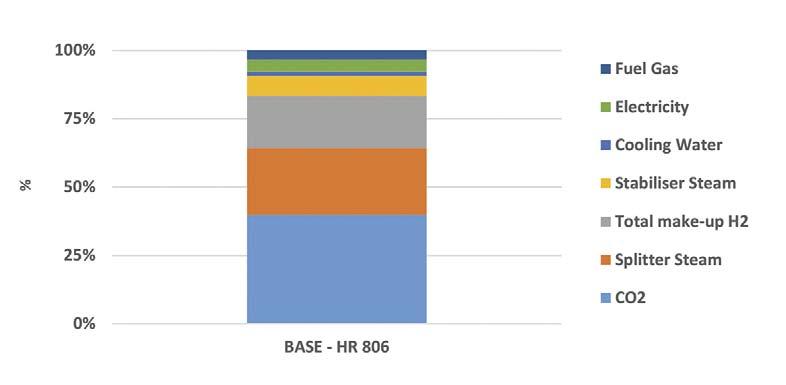
Figure 2. Base case utilities cost breakdown. energy to be brought to the system, generally under the form of high pressure (HP) steam.
On the catalyst side, as on the licensing side, Axens offers solutions for FCC gasoline hydrotreatment. In the HDS section, HR 806 and HR 846, used alone or in combination with HR 841 for better octane retention, allow for the desulfurisation of the most refractory species encountered in the gasoline boiling range while preserving olefi ns.
During the last decade, IFPEN and Axens have focused their catalyst R&D on performance, with selectivity being one of the targeted development lines. As a result, a new generation HDS catalyst (HR 856) has been released, which allows for the same excellent HDS activity and resistance to contaminants as HR 806 and HR 846 but with signifi cantly lower olefi ns saturation. This new generation catalyst can help refi ners to push for further octane savings and reduce energy consumption.
Unit utilities bill
Unit performance would not be achieved without the introduction of a certain amount of energy. In a scenario where global policies target large CO2 emission cuts and require industries to reduce their emissions and eventually to pay for it (through carbon tax or by emission allowances under cap-and-trade systems), assessing the unit performance in a low energy consumption mode is more relevant than ever.
A case study was conducted for a reference FCC gasoline hydrotreatment unit to gain a picture of the energy bill inside the unit. The unit treats 20 000 bpd of a typical full range FCC gasoline from 1000 wtppm of sulfur down to 10 wppm. The unit has a selective hydrogenation section (SHU), a splitter and a one stage HDS section with two reactors and a heater in between. The HDS section is fi tted with a recycle gas loop. The design is representative of the earliest one stage FCC gasoline hydrotreatment units that were commissioned by Axens, which means it does not benefi t from the latest design improvements for energy savings. Loaded catalysts are benchmark SHU and HDS catalysts.
For the different case studies presented in this article, the price of utilities is based on averages from Axens’ project database. For CO2, a price of US$65/t is assumed based on the price range considered by the oil industry in investment decisions (from US$25/t to US$100/t).
The CO2 emission factors expressed in CO2 t/unit of utilities produced is summarised in Table 1.
Looking at the breakdown of CO2 emissions and utilities for the reference unit on Figures 1 and 2, the following conclusions can be drawn: Steam is the biggest contributor to the utilities expenses not including CO2 and also the biggest contributor to
CO2 emissions. 70% of the total steam consumption is for the splitter. Hydrogen consumption is the second biggest contributor to the utilities expenses, not including CO2, and also the second biggest contributor to CO2 emissions. Electricity is not a major contributor to the operating expenses nor to CO2 emissions. 43% of the total electricity consumption is for the recycle gas compressor. CO2 emissions become critical when considered as an operating expense. Even if CO2 is not yet considered as an operating expense by all refiners, many oil and gas companies tend to apply an internal carbon price when evaluating investment decisions (either static value or a range of values that changes over time). Looking at the mid-term (2030), considered carbon prices can be much higher than the one considered in the present case study.1,2
In an attempt to reduce the utilities bill and the CO2 emissions as much as possible, acting on both the splitter steam consumption and the make-up hydrogen consumption thus seems inevitable. On the other hand, acting on the power consumption shall probably not be regarded as a priority.
Figure 3. CO2 emissions and unit profitability: comparison splitter low pressure to BASE CASE.
Figure 4. CO2 emissions and unit profitability: comparison splitter low reflux ratio to BASE CASE.
Figure 5. Comparison of compressor low electricity consumptions to BASE CASE.

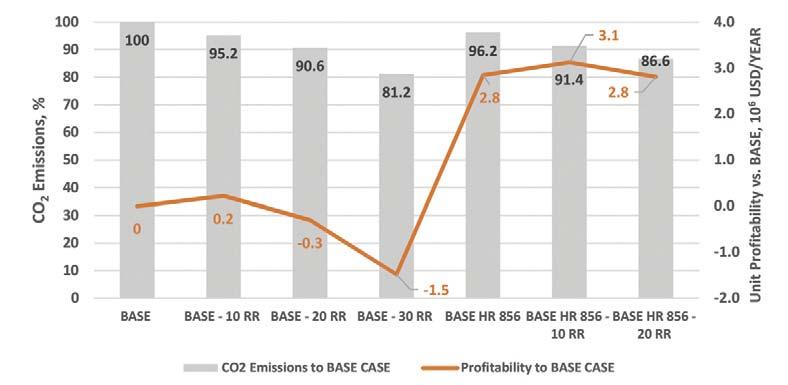
The different low energy scenarios
Two ideas come to mind when it comes to reducing the splitter steam consumption, each one having specifi c undesirable consequences in terms of performance: Decreasing the operating pressure. This has an impact on the product yield as some valuable C5 could be lost to the purge and end up in the fuel gas system or at the flare. Decreasing the reflux to feed ratio. This has an impact on the light cracked naphtha (LCN) recovery and ultimately on the octane retention and the hydrogen consumption, as some light olefins are dropped into the HDS feed with the risk of being hydrogenated.
These two scenarios will be explored and it can be seen how the use of Axens’ new generation HDS catalyst HR 856 can offset any loss in performance arising from a low energy operation. The result for the refi ners is a signifi cant increase in profi tability and a signifi cant decrease in CO2 emissions.
A third scenario will also be investigated, which is a decrease of electricity consumption through a decrease of the HDS recycle gas compressor throughput. This should help to defi nitely rule out this solution as a major path towards energy savings.
The economics will use a product price of US$600/t (gasoline SP 95) and an octane value of US$0.9/octane bbl (AKI based).
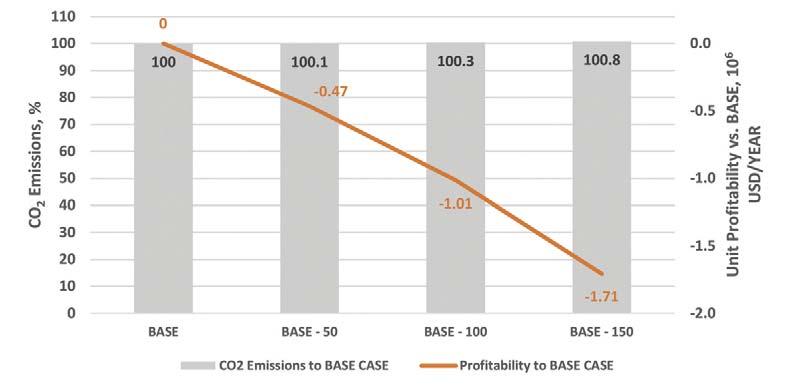
Splitter steam reduction
The operating parameters of the reference unit have been modifi ed in terms of splitter operating pressure and splitter refl ux to feed ratio, fi rst with HR 806 and then with HR 856 (Figures 3 and 4). The BASE case considers standard operation conditions for the splitter in terms of pressure and refl ux ratio. Running case BASE -1 bar means that the unit splitter pressure has been lowered by 1 bar. Concerning the refl ux ratio, BASE -10 refl ux ratio (RR) means that the refl ux ratio has been lowered by 10%.
As mentioned, operation at lower pressure causes a loss of yield, thus degrading the product value. With HR 806 loaded, this operation shows positive net incomes only when the switch from HP steam to MP steam is possible.
Low refl ux ratio operation causes higher octane losses which degrades the product value. However, with HR 806, running at BASE-10 RR is profi table. For RR of BASE -20 RR and below, savings in utilities do not compensate the losses in octane value.
At BASE conditions, a substantial gain of US$2.8 million/yr is obtained by switching to HR 856. At the optimum pressure conditions, i.e. BASE -2 bar, considering that a switch to medium pressure (MP) steam is possible, the gain reaches US$3.7 million/yr.
In terms of RR, the most profi table option with HR 856 is BASE -10 RR, leading to a gain of US$3.1 million/yr. BASE -20 RR still shows signifi cantly better profi tability than the BASE case with HR 806 and the reduction of CO2 emissions reaches 13%.
Splitter low energy modes are very profi table when conjugated with a switch to HR 856, and the impact on CO2 emissions is signifi cant.
Power consumption reduction
Operation feedback from the last 20 years show that refi ners often challenge the HDS section H2/HC design value, considered as high especially when compared to conventional naphtha hydrotreaters.
Although the positive impact on electricity consumption from a lower H2/HC ratio might be appealing, one should keep in mind the negative effects on the catalyst performance, including: The catalyst activity is decreased, which has to be compensated by a higher operating temperature to keep the product on spec. The selectivity of the catalyst is decreased, meaning a higher octane loss and a higher make-up H2 consumption can be expected for the same product spec.
The results from the study shown in Figure 5illustrate that the reduction in electricity consumption does not compensate the loss of product value. Besides, the cycle length reduction due to higher weighted average bed temperature (WABT) in the HDS reactor has not been taken into account, which would tip the balance in favour of other strategies even more.


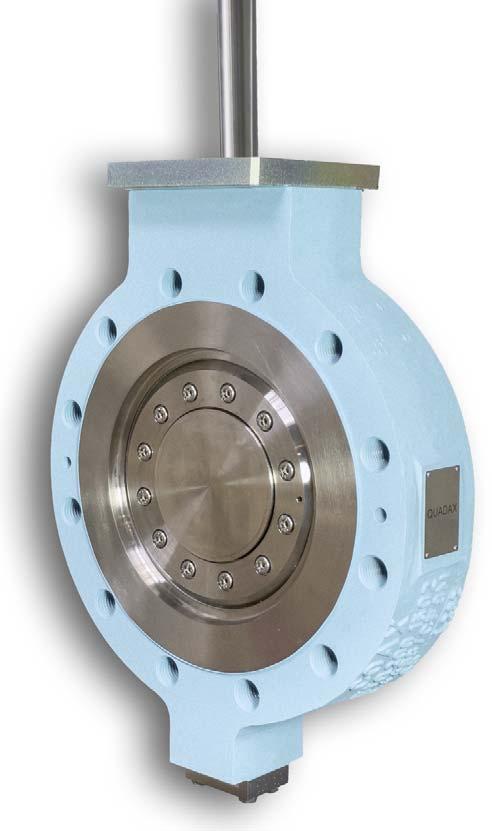
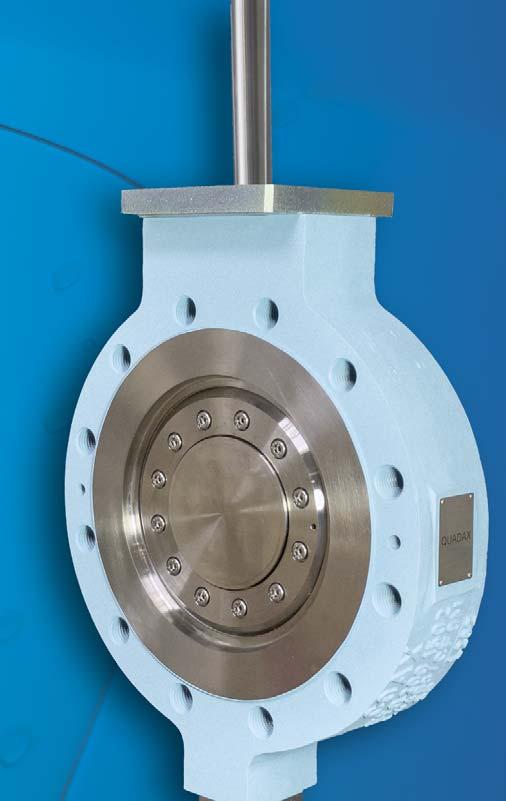


GLOBAL MARKET LEADER* 2021
It is convenient, however, to indicate that in the case of a steam-driven compressor, a different assessment would have to be conducted.
The digital role
In parallel with catalyst R&D, Axens has put signifi cant efforts into the development of digital applications aiming to improve customer experience, maximise profi tability and help to control CO2 emissions.
For example, the Connect’InTM application includes a performance delta dashboard, which offers the possibility to model the unit using proprietary models and to compare in real time the actual performance vs the inferred one. This helps refi ners to detect any deviation to the optimum operation and identify the parameters that can be tuned with the support of technical services engineers.
It is observed that units often over-perform in terms of desulfurisation, which has cost implications in terms of octane, utilities consumption and CO2 emissions. The use of an advanced process control (APC) based on licensor’s in-house models inferences would automatically avoid these performance issues with a fast payback. An APC would also help the refi ner set the optimum operating parameters based on both energy consumption and product value.
By using real time fl uid properties analysis (fl uid properties as a service [FPaaS]), the digital experience is enhanced: the use of relevant near infrared (NIR) solutions as a real time properties analyser is providing results as expected in the improvement of inference models. In the context described in this article, limited to operating expenses in early FCC gasoline hydrotreatment designs, it has been shown that an overhaul of the operating parameters might be a good step to take.
The use of the high selectivity catalyst HR 856 allows profi tability to be combined with a reduction in CO2 emissions to get the best of both worlds. This is even more signifi cant when applying a price for CO2.
It has also been shown that decreasing the splitter operating pressure and decreasing the splitter refl ux to feed ratio are probably the fi rst actions to consider to decrease the utility/CO2 bill. This is site-dependant, and the optimum parameters have to be set case-by-case.
In a case-by-case setting scenario, digitalisation becomes a powerful tool to defi ne the optimum parameters, demonstrating that an integrated offer is gaining in importance and that a catalytic solution, only by itself, is no longer in position to respond to refi ners interests.
Other scenarios, considering capital expenses, would lead to more optimised schemes. This can be achieved by means of a revamp, in the case of existing units, or by the implementation of the latest state-of-the-art design, for grassroot units.
References
1. ‘Getting to Net Zero’, Total, (September 2020). 2. ‘Progressing strategy development, bp revises long-term price assumptions, reviews intangible assets and, as a result, expects non-cash impairments and write-offs’, BP, (15 June 2020), https://www.bp.com/en/global/corporate/news-and-insights/pressreleases/bp-revises-long-term-price-assumptions.html











